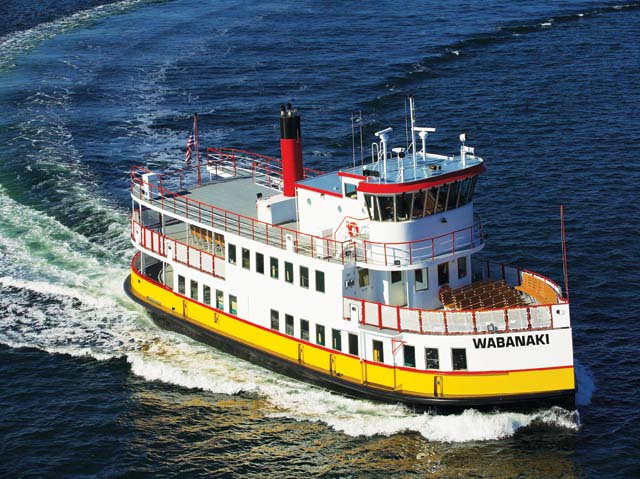On the first weekend in 2014, Blount Boats delivered the Wabanaki, a new 110'4"×32'×6'4" passenger ferry, to the Maine Department of Transportation. This is the eighth ferry built by the Warren, R.I., boatyard to be operated by Maine’s Casco Bay Island Transit District in Portland. The first boat was the Aucocisco II built in 1953.
Designed by Rolls-Royce, the Wabanaki carries up to 399 passengers on two levels and runs year-round out of Portland to six islands in Casco Bay. With its vertical bow, wheelhouse set well back from the bow and a single, tall stack behind the house, the Wabanaki resembles old steam-powered ferries.
But this is 2014, so instead of steam-generated propulsion, the Wabanaki has a pair of diesel engines, 450-hp Caterpillar C18s matched up to Twin Disc MGX-516 marine gears with a 3.5:1 ratio, turning 48"×39", 4-bladed props on 3 ½" Aquamet shafts. That propulsion package gives the Wabanaki a top speed of 13.7 knots and a cruising speed of 11.3 knots.
You wouldn’t necessarily think so, but those shafts were a problem. The Wabanaki was funded by a grant from the Federal Highway Administration, which has a “Buy America” section requiring that “the vessel has to be 100 percent American built, including the steel. It goes back to where the steel was melted,” said Rolls-Royce’s Gerry McGovern. On the other hand, Federal Transit Administration grants permit 40 percent foreign content.
Locating domestic structural steel for the Wabanaki wasn’t a problem, but, “specialized steel, such as shafting, is very difficult to come by,” McGovern said. “Eventually after a rigorous search across the country and working with some steel mills, we found material for the shafting, but it was a challenge.”
A 1994 waver for the construction of ferries allows some equipment, mostly electrical and engines to be foreign built, but not shafting, props or reduction gears. However, by coupling the gear with the Cat diesel and delivering the pair to Blount Boats as a single unit — not two — McGovern said the running gear could be included as part of the propulsion package.
The Wabanaki’s basic design is the same as another Casco Bay boat, the nine-year-old Aucocisco III built by Steiner Shipyard in Alabama, but with a few differences.
“The Aucocisco III has cargo storage for carts, but it was intended more for the free flow of passengers,” McGovern said. “They needed a way for cargo to move quicker.” Thus the Wabanaki was designed with separate cargo areas on each deck. “They can store carts directly away from the passengers and not interfere with the passenger flow.”
The Wabanaki also has more of its superstructure enclosed. With Casco Bay’s high winds, maneuvering could be a problem, so a Wesmar 18-inch electric bowthruster was installed. The Aucocisco III doesn’t have a thruster.
— Michael Crowley




